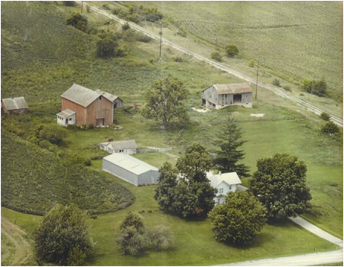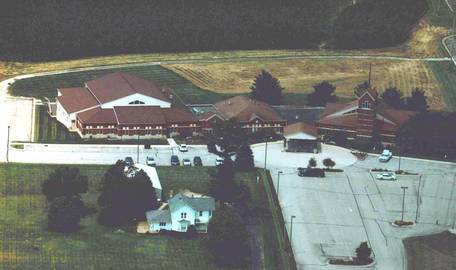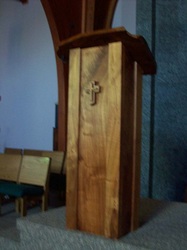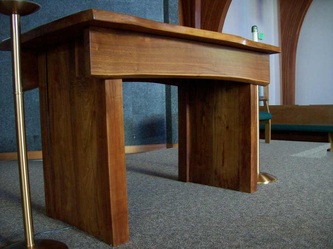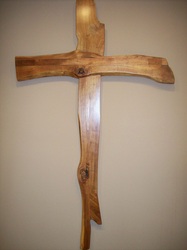St. Mary Solon - History
A Parish Begins
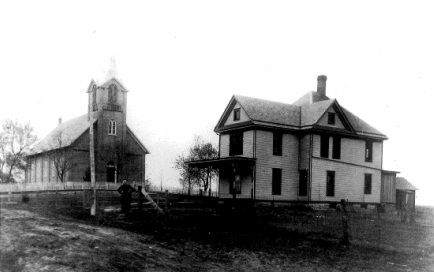
St. Mary's Church was built in 1875 and Rectory in 1904
Our parish originated as a mission of St. Mary's Church in Iowa City. It grew under the direction of several enthusiastic priests. The first Mass in Solon was conducted by Rev. Mathias Hannon in 1853 for a congregation of four families who crowded into one home. It became evident that a church building was needed in Solon. Rev. Edmonds took charge of the endeavor and helped the congregation build its first house of worship in 1858 - a wooden church which burned to the ground according to early settlers.
In 1875, work began on a brick structure. Everyone in the young parish was involved in the construction. Bricks were fired on the Meyer farm. The Costello brothers hauled sand from the river. Limestone was brought in from the Beuter quarry. Most of the handiwork was handled by the men of the parish. Mass was said in the homes of townspeople until the dedication on May 17, 1882.
At the turn of the century, St. Mary's congregation was quite active in the bustling community of Solon. Socials, lawn parties, oyster suppers and ice cream sociables were offered for the whole town. The highlight each year was the annual Fourth of July celebration with picnic dinners and music.
In 1875, work began on a brick structure. Everyone in the young parish was involved in the construction. Bricks were fired on the Meyer farm. The Costello brothers hauled sand from the river. Limestone was brought in from the Beuter quarry. Most of the handiwork was handled by the men of the parish. Mass was said in the homes of townspeople until the dedication on May 17, 1882.
At the turn of the century, St. Mary's congregation was quite active in the bustling community of Solon. Socials, lawn parties, oyster suppers and ice cream sociables were offered for the whole town. The highlight each year was the annual Fourth of July celebration with picnic dinners and music.
A Growing Catholic Community
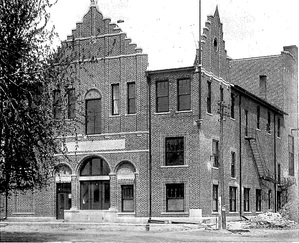
Catholic Auditorium and Club House
On May 3, 1905, a class of about 80 were confirmed. "The congregation that gathered taxed the capacity of the church to its utmost." In 1915, plans began for a building with a large auditorium to be used for plays, movies, dances and social gatherings. A gymnasium and bowling alley were planed for the young people, along with a library, billiard tables and a ladies' parlor.
As the roaring twenties entered Solon, the activities increased at the auditorium: minstrel shows, movies, card parties and senior plays, Baccalaureate services and luncheons continued to take place throughout the years, except the 40 days of Lent. However, following Easter Sunday, the community would come alive again. The Fall Festival chicken dinners would serve up to 1,000 dinners. Groups such as the Altar Society, Catholic Order of Foresters, and Ladies of Sodality flourished in the parish.
Post-War Period
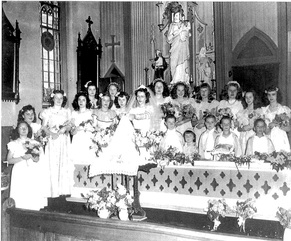
The annual May crowning ceremony became an important event on the parish calendar beginning at the auditorium with a procession to the church. More parish groups were formed helping people stay involved in the church including the Holy Name Society, Girls Sodality, and Church Circles which held dances, card parties and fundraisers. Neighborhood groups gathered to pray the Rosary. Men's study clubs met to share about faith and life.
There was a strong sense of community and never a hesitation to help anyone in need. Retreats and Cana conferences were offered for young couples and classes in Christian Apologetics were offered for high school students. Much of the 1950s was devoted to remodeling.
A Center of Community Activity
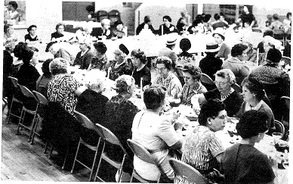
In the 1960s, the custom of ringing the church bells three times each day returned to St. Mary's. The Angelus was rung at 6 am, noon and 6 pm. This thrice ringing commemorated the Annunciation and the Passion of Christ and His death and it also reflected the Holy Trinity. In addition, Pope Pius XII had asked for the ringing to counter the "church of silence," Communist countries and other areas where dictatorships suppressed Church life. Activities sponsored by various parish groups continued to take place for the parish and larger community: card parties, field trips, potlucks, dances, bake sales and fashion shows. After nearly five decades of much use, the auditorium was updated and remodeled. In 1974, the church underwent another renovation. As organizations and traditions came and went, people continued to participate in the life of the parish.
A New Church
In the 1980s, the population of Solon and its surrounding areas were steadily growing. In 1985, there were 150 children in the religious education program, by 1998 the numbers had doubled. In 1965, there 234 families at St. Mary's. By 1996, there were 375 families - but only seating for 180 people in the church. With a cemetery on both sides of the church, there was no way to expand the existing structure. "The people on either side would object," Fr. Lenoch would chuckle. The parish purchased 20 acres on the West side of Solon with plans to build a new church and parish life center.
At the groundbreaking on June 7, 1997, Bishop Franklin noted, "While we appreciate what our grandparents and parents have done for us," reflecting on120 years in the existing church, "we must also have the foresight, wisdom and the generosity to live and plan for the future. That's what you have done.We are celebrating the start of a new family home. Welcome home." Almost a year later, on April 25, 1998, the first Mass was celebrated. The parish center was added in 2006.
The wood from the walnut tree (between the two barns in picture above right) was used to make the main altar, ambo and table for the
tabernacle in the church along with the wooden cross hanging in the hall entrance above the stairs.
Area Rural Parishes
The roots of the current parish of St. Mary Church go beyond the town of Solon.
There are families who have joined this parish over time as their rural parishes were closed.
The roots of the current parish of St. Mary Church go beyond the town of Solon.
There are families who have joined this parish over time as their rural parishes were closed.
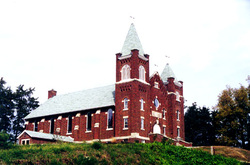
St. Peter & Paul Catholic Church, approximately three miles north of Solon, was established around 1861 by the Czech Bohemian immigrants who settled in this area. Their first church building was made of stone hauled by oxen from over five miles away. It served them until the new one was completed in 1917. The inscriptions on the stained glass windows and stations of the cross are in Czech. The marble altar was shipped from Italy. The picture of St. Peter and Paul in the vestibule was brought over from Europe, painted around 1861. For many years, the church was the hub of activities. It was a place for weddings, solitude, funerals and a place to celebrate the sacraments. Corpus Christi Day was an annual celebration held after Easter. Unfortunately, the church was not immune to changes happening in society. Younger people moved from the farms to the city with their families causing the size of the congregation to decrease. St. Peter and Paul Catholic Church closed its doors on June 30, 1996, but it will not be forgotten. Many of today's elderly still living in the community have ties and memories that filter down through the years along with the traditions and heritage of the Czech culture. Information from www.sts-peterandpaul.org
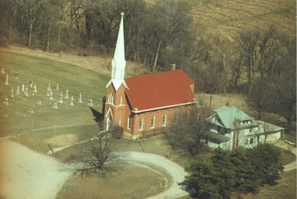
St. Bridget, the Church at Nolan Settlement Before 1860, Father William Edmonds, pioneer priest of St. Mary's of Iowa City, made the arduous trip in a bobsled or wagon once a month to say Mass in the log cabins of the settlers southeast of Solon. He coaxed Mr. Nolan, who dwelt in the woods, "If you help with the other 4 families to erect a little church for the honor of God, we shall name the place of settlement Nolan Settlement." Forty acres was then purchased for $250, and, in 1863, the first frame structure was erected in what is now the cemetery. Although it was but 20 x 30 feet, it served also as the only schoolhouse for miles around. Here the children of early settlers received their educations during the long winter months. In 1894, the present brick structure was built by Father Mahoney from the same plans as was St. Wenceslaus of Iowa City to accommodate a parish of 80 families. The first Mass was said on Christmas Day of the same year. St. Bridget's last Mass took place on June 30, 1996, with over 200 worshipers attending. Ongoing Memorial Day Mass: Bring your lawn chair, family and friends to help us celebrate Memorial Day with Mass in St. Bridget’s cemetery followed by a program in the church honoring veterans, deceased family and all members of St. Bridget’s community.Information from: "History of St. Bridget's Church of Nolan Settlement" written by Dorothy Worrell Platteter of Solon
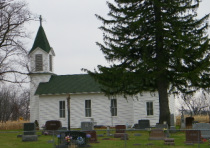
St. Mary, Newport Mission Church of Iowa City
